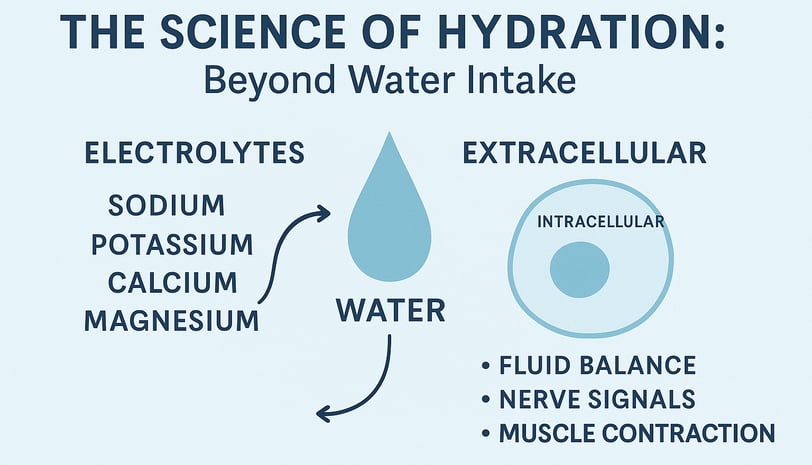The Science of Hydration: Why Water Alone Isn’t Enough
Discover how electrolyte balance drives true hydration. Learn the science, explore studies, and see the best Amazon products to optimize performance, cognition, and recovery.
5/15/20253 min read


The Science of Hydration: Beyond Water Intake
When we talk about staying hydrated, most of us immediately think: “Drink more water.” But water alone isn’t enough—our bodies need electrolytes, too. These electrically charged minerals (sodium, potassium, calcium, magnesium, chloride, phosphate) govern fluid distribution between cells and bloodstream, power nerve impulses, and drive muscle contractions. Without the right balance, you can guzzle water and still feel off—headaches, cramps, dizziness, fatigue. Let’s dive deeper into the science of hydration, explore cutting-edge research, and share practical tips (plus smart Amazon picks) to optimize your fluid balance.
1. Physiology 101: How Electrolytes Drive Hydration
Our total body water splits roughly 60% inside cells (intracellular) and 40% outside (extracellular). Osmotic gradients—differences in ion concentration—pull water through membranes. Sodium is the main extracellular cation; potassium reigns inside cells. When sodium concentration rises in your blood (say, from a salty snack or electrolyte drink), water follows, expanding blood volume and boosting circulation. Magnesium and calcium help regulate muscle and nerve function—making electrolytes the gatekeepers of hydration.
2. Evidence from the Lab: Studies on Electrolyte Supplementation
A 2019 meta-analysis in the Journal of the International Society of Sports Nutrition found that electrolyte drinks with sodium and carbs improved endurance by 8–12% compared to plain water. Another 2018 cognitive study showed that even mild dehydration (1.5% body weight loss) reduced mental performance, while rehydration with electrolytes reversed the drop within 30 minutes.
Clinically, the importance of balance is massive. A 2022 review in Critical Care Clinics found that electrolyte disorders (like hyponatremia or hypernatremia) were tied to higher ICU mortality. From elite athletes to hospital patients, the takeaway is clear: electrolytes aren't optional—they’re foundational.
3. Who Needs More Than Water?
Endurance athletes: Sweating for more than 60 minutes? You're likely losing 500–1000 mg of sodium/hour.
Heavy sweaters or hot climates: High temps and humidity increase sweat and salt loss.
Sick days or travel: Vomiting, diarrhea, or long-haul flights can quickly dehydrate your system.
If you feel fatigued, crampy, foggy-headed, or unusually thirsty—even after drinking water—electrolyte loss might be to blame.
-LMNT Zero Sugar Electrolytes
This is the go-to for serious performance: 1,000 mg sodium, 200 mg potassium, and 60 mg magnesium per packet—without sugar or artificial ingredients.
Why it fits here: If you’re training hard, sweating buckets, or fasting, LMNT restores what you’re burning through.
Best time to use: Before long workouts or during extreme heat conditions.
Check LMNT Electrolyte Drink Mix on Amazon
4. Personalized Hydration Strategy
Hydration isn’t one-size-fits-all. Build a plan based on:
Sweat rate: Weigh yourself before and after exercise. Every pound lost = ~16 oz of fluid.
Electrolyte load:
<1 hr workouts = water or light electrolytes
1–2 hr = ~300–500 mg sodium
2+ hrs = 800–1,000 mg sodium
Timing:
Pre: 200–300 mL 15–30 minutes before
During: 150–200 mL every 15–20 minutes
Post: Full serving of your mix with a recovery meal
Also lean on food: Bananas (potassium), yogurt (calcium), pumpkin seeds (magnesium), and broth (sodium) are whole-food allies in hydration.
-Ultima Replenisher Electrolyte Mix
If you’re not dripping sweat but still want balanced support, Ultima offers 6 key electrolytes with zero sugar and no calories. It’s ideal for workdays, post-walks, or casual workouts.
Why it fits here: Perfect for moderate activity, wellness routines, or even dry environments (AC, flights).
Best time to use: Midday, post-gym, or in the office.
Check Ultima Replenisher Electrolyte Powder on Amazon
5. Real-World Case: Runners & Cyclists
A 2023 study followed 20 recreational runners during a 10K. Half received water, the others a 300 mg sodium electrolyte drink. The electrolyte group experienced 25% fewer cramps and lower perceived exertion. It’s not just about energy—it’s about keeping your neuromuscular system firing under stress.
Experts like Dr. Stacy Sims also stress "electrolyte microdosing"—frequent small sips rather than gulping. This maintains plasma osmolality, minimizing nausea or bloating.
-SaltStick FastChews
SaltStick makes chewable tablets with a great sodium-potassium-magnesium-calcium mix.
Why it fits here: No mixing, no bottles—just chew and go. Perfect for long hikes, bikes, or when you need something fast.
Best time to use: On-the-go workouts, travel days, or mid-race support.
Check SaltStick FastChews on Amazon
Conclusion
Hydration isn’t just about water—it’s about balance. Electrolytes like sodium, potassium, and magnesium direct water to the right places, regulate performance, and keep your mind sharp. With science-backed strategies and high-quality tools like LMNT, Ultima Replenisher, and SaltStick FastChews, you can personalize your approach and stay truly hydrated—whether you're training hard or just powering through a busy day. Drink smarter, not just more.
FITNESS
Nutrition
WellnesS
info@movebetterco.com
© 2025. All rights reserved | Privacy Policy | Terms & Conditions